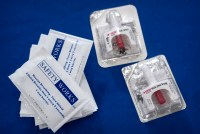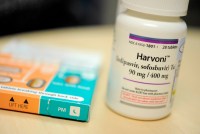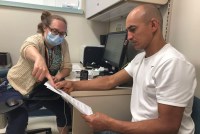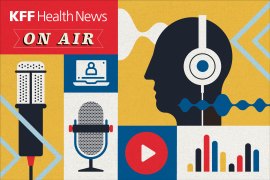Latest KFF Health News Stories
Doctors Abandon a Diagnosis Used to Justify Police Custody Deaths. It Might Live On, Anyway.
The American College of Emergency Physicians agreed to withdraw its 2009 white paper on excited delirium, removing the only official medical pillar of support left for the theory that has played a key role in absolving police of culpability for in-custody deaths.
Narcan, Now Available Without a Prescription, Can Still Be Hard to Get
Narcan is available without a prescription. Addiction treatment experts hope this move will increase access to the medication, which can reverse opioid overdoses. But hurdles remain: cost and stigma.
Police Blame Some Deaths on ‘Excited Delirium.’ ER Docs Consider Pulling the Plug on the Term.
The American College of Emergency Physicians will vote in early October on whether to disavow its 2009 research paper on excited delirium, which has been cited as a cause of death and used as a legal defense by police officers in several high-profile cases.
Who Polices Hospitals Merging Across Markets? States Give Different Answers
Increasingly, hospitals are merging across separate markets within states. It’s a move that health economists and the Federal Trade Commission have been closely watching, as evidence shows such mergers raise prices for patients with no improvement in care.
Resurge la hepatitis C, ¿podrá el plan de Biden eliminar este viejo flagelo en cinco años?
Se calcula que el 40% de los más de 2 millones de personas con hepatitis C en Estados Unidos ni siquiera saben que la tienen, pero el virus puede estar dañando silenciosamente su hígado, causando cicatrices, insuficiencia hepática o cáncer de hígado.
Hep C’s Number Comes Up: Can Biden’s 5-Year Plan Eliminate the Longtime Scourge?
Before covid-19, hepatitis C held the distinction of claiming more American lives each year than any other infectious disease — that’s despite the marketing of several relatively affordable, highly effective treatments.
No existen normas federales para proteger a los trabajadores cuando los días son excesivamente calurosos. Y sin el apoyo bipartidista del Congreso, incluso con la atención urgente de la administración Biden, es posible que el alivio no llegue en años.
Workers Pay the Price While Congress and Employers Debate Need for Heat Regulations
Studies suggest official numbers vastly underestimate heat-related injuries and illness on the job. To institute protections, the government must calculate their cost — and the cost of inaction.
When Temps Rise, So Do Medical Risks. Should Doctors and Nurses Talk More About Heat?
The medical dangers of heat are real. But people often ignore public heat alerts or don’t realize how vulnerable they are. A new alert system prompts clinicians to talk about heat with patients.
Naming Suicide in Obits Was Once Taboo. Changing That Can Help Loved Ones Grieve.
Mental health is being talked about more openly than ever, but the word “suicide” has remained largely taboo when describing how someone died. See why that’s slowly changing, what it means for people who grieve those deaths, and how candor can help prevent additional suicides.
A New Medicare Proposal Would Cover Training for Family Caregivers
The federal government is proposing having Medicare pay professionals to train family caregivers how to perform tasks like bathing and dressing their loved ones, and properly use medical equipment.
Parents See Own Health Spiral as Their Kids’ Mental Illnesses Worsen
The day-to-day struggles that parents of kids with mental health conditions must navigate have led to their own crisis: The stress can take a physical toll that disrupts parents’ ability to provide care, say psychologists, researchers, and advocates for families.
New Alzheimer’s Drug Raises Hopes — Along With Questions
Clinics serving Alzheimer’s patients are working out the details of who will get treated with the new drug Leqembi. It won’t be for everyone with memory-loss symptoms.
Voters Rejected an Anti-Abortion Measure. State GOP Lawmakers Passed a Similar Bill Anyway.
The new Montana law contains a couple of significant differences from the measure voters rebuffed last fall.
Lost Medicaid Health Coverage? Here’s What You Need to Know
Patient advocates are tackling the “overwhelming task” of connecting people with health insurance as millions lose coverage due to the end of pandemic protections on Medicaid eligibility.
Pioneering Study Links Testicular Cancer Among Military Personnel to ‘Forever Chemicals’
The military first documented health concerns surrounding chemicals known as PFAS decades ago yet has continued to use firefighting foam made with them. Despite scores of lawsuits by its personnel and high rates of testicular cancer among troops, it has been slow to investigate a connection.
Pain Clinic Chain to Pay $11.4M to Settle Medicare and Medicaid Fraud Claims
The owner of one of California’s largest chains of pain management clinics has agreed to pay California, Oregon, and the federal government to settle Medicare and Medi-Cal fraud allegations.
Proposed PFAS Rule Would Cost Companies Estimated $1B; Lacks Limits and Cleanup Requirement
A proposed Environmental Protection Agency rule calls for companies to disclose PFAS manufactured or imported since 2011. The chemical industry is upset because such compliance would cost an estimated $1 billion, while environmental health advocates worry because the rule wouldn’t ban the chemicals outright.
Montana Adds Protections for Kids in Private Residential Treatment Programs
Programs in the so-called troubled teen industry will be required to provide a 24-hour hotline and unmonitored video calls with family and be subject to more inspections under a new Montana law.
As Low-Nicotine Cigarettes Hit the Market, Anti-Smoking Groups Press for Wider Standard
The first FDA-authorized cigarettes with 95% less nicotine than traditional smokes will go on sale in California, Florida, and Texas starting in early July. Anti-smoking groups oppose greenlighting just one plant biotech’s products and instead urge federal regulators to set a low-nicotine standard for the entire industry.
























